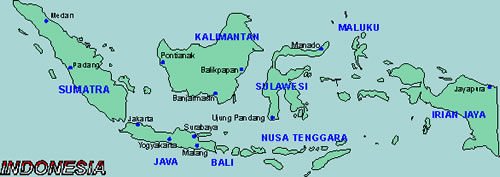
Indonesian (Bahasa Indonesia)
Indonesian (Bahasa Indonesia ‘language of Indonesia’) is a member of the Malayo-Polynesian branch of the Austronesian language family. Bahasa Indonesia is a standardized dialect of Malay which had been used as a lingua franca in the Indonesian archipelago for centuries, and which achieved the status of an official language with the declaration of independence of Indonesia from the Netherlands in 1945. The two languages are very similar in their sound system, grammar, and vocabulary.
Status
Indonesian is the statutory national language of Indonesia where it is spoken by close to 23 million people. It is a second language for another 140 million people (Ethnologue). Most Indonesians are bilingual, and many are proficient, to varying degrees, in three or four languages. They learn at least one of the country’s many local languages at home, and later learn Indonesian in school. Generally, Indonesian tends to be used in larger urban areas, while local languages are more widely used in small towns and 
Indonesian is the official language of government administration and serves as the medium of instruction at all levels of education, although English textbooks are used in specialized university courses. It is the dominant language of the country’s mass media. Domestic TV programs are entirely in Indonesian, and almost all foreign programs are subtitled or dubbed into Indonesian. It is also the language of literature and popular culture such as TV melodramas and comedy, pop novels, popular songs, cartoons, and comics.
Dialects
Indonesian has a number of dialects based on geography and on social status.
Regional variations
These dialects differ mostly in pronunciation and, to a lesser extent, in vocabulary.
- The northern dialect, referred to as Malay, is spoken in Malaysia, Singapore and Brunei.
- The southern dialect is spoken in Indonesia. It is further subdivided into western and eastern varieties which, in turn, have a number of regional dialects.
- The western variety is spoken throughout Sumatra, Borneo, Java, Bali, Lombok, Sumbawa and most of Sulawesi.
- The eastern variant is spoken in the north of Sulawesi, the Maluku islands, in Flores, Timor and in Western New Guinea.
Social registers
Indonesian is characterized by significant differences between formal and informal registers.
- The formal register is used in public speeches, formal writing, and in educational settings. It is characterized by a large number of borrowings from Sanskrit, Arabic and other foreign languages.
- The informal register is used in everyday conversations. It is characterized by a significant number of borrowings from local languages.
- Standard Indonesian is based on the formal variety of the language spoken in Jakarta, the capital of Indonesia.
Structure
Sound system
The sound system of Indonesian is similar to that of Malay.
Vowels
Indonesian has six vowel phonemes, i.e., sounds that can make a difference in word meaning.
| Close |
i
|
u
|
|
| Mid |
e
|
ə
|
o
|
| Open |
a
|
- /ə / = a in about.
Consonants
The consonant system of Indonesian is fairly simple. Syllables in native words do not have consonant clusters and typically consist of an optional Consonant + Vowel or Vowel + Vowel. Loanwords frequently contain consonant clusters, e.g., struktur ‘structure’.
The table below shows the consonant phonemes of Indonesian. Consonants in parentheses occur exclusively in borrowed words.
| Labio-dental | |||||||
|---|---|---|---|---|---|---|---|
| Stops | voiceless |
p
|
t
|
k
|
ʔ
|
||
| voiced |
b
|
d
|
g
|
||||
| Fricatives | voiceless |
(f)
|
s
|
(ʃ)
|
(x)
|
h
|
|
| voiced |
(v)
|
(z)
|
xx | ||||
| Affricates | voiceless |
tʃ
|
xxx | ||||
| voiced |
dʒ
|
||||||
| Nasals |
m
|
n
|
ɲ
|
ŋ
|
|||
| Laterals |
l
|
||||||
| Trill |
r
|
||||||
| Approximants |
w
|
.xxx |
j
|
||||
- /ʔ/ = sound between vowels in uh-oh
- /ʃ/ = sh in shop
- /tʃ/ = ch in chop
- /dʒ/ = j of job
- /x/ has no equivalent in English
- /ɲ/ = first n in canyon
- /ŋ/ = ng in song
Stress
Stress does not distinguish word meaning since it regularly falls on the penultimate (next to the last) syllable in a word.
Grammar
Indonesian grammar has many features in common with other Malayo-Polynesian languages.
Nouns
- Nouns are not marked for number, gender or definiteness. These categories are usually inferred from context, unless there is an important distinction to be made. For instance, plurality can be conveyed by reduplication of a noun, e.g., babi ‘pig’, babi-babi ‘pigs’, orang ‘person’, orang-orang ‘people’.
- Definiteness can be represented by a demonstrative pronoun , e.g., babi itu ‘the, that, those pigs’. Indefiniteness can be indicated by the numeral satu ‘one’ abbreviated to se-, e.g., sebuah rumah ‘a house’.
- Words such as ‘male’ or ‘female’ can be used to indicate gender. For example, adik refers to siblings of both sexes. To indicate the male gender, an adjective is used, e.g., adik laki-laki means ‘male sibling’.
- Quantifiers normally consist of a numeral followed by a classifier. There were dozens of classifiers in Classical Malay, e.g., butir for small round objects, batang for stick-like objects, etc. However, in modern Indonesian, there are only three quantifiers, namely buah ‘fruit’ for inanimate nouns, ékor ‘tail’ for animate non-human nouns, and orang ‘person’ for human nouns.
Pronouns
Indonesian is rich in pronouns.
- Personal pronouns are marked for person.
- Most pronouns are marked for familiarity and formality.
- There is an inclusive 1st person plural pronoun, i.e., one that includes the addressee, and an exclusive 2st person pronoun, i.e., one that excludes the addressee.
- In all formal situations, personal names, kinship terms, or titles are used in place of 2nd person pronouns.
Verbs
- Verbs are not marked for person or tense. These categories are either inferred from context or expressed by adverbs, time words or clauses.
- There is a three-way aspect distinction between action completed, action begun but not completed, and action not completed. These distinctions are represented by special markers.
- Voice and transitivity are marked by affixes.
- Mood is expressed by adverbs or other auxiliary words.
Word order
The neutral word order in Indonesian is Subject-Verb-Object. However, other word orders are possible, depending on emphasis and style. For instance, words constituting the focus of a sentence (part of the sentence that contains the most important, or new information) usually appear in initial position. Modifiers normally follow the noun they modify. Quantifiers usually precede nouns.
Vocabulary
The vast majority of Indonesian words are of Austronesian origin. Indonesian shares over 80% of its vocabulary with Standard Malay. Most native Indonesian words consist of two syllables. Words are mostly formed by derivation, drawing on a set of about 25 derivational affixes. Reduplication is also very common, e.g., kuda ‘horse’, kuda-kuda ‘saw horse’. There are numerous borrowings from Arabic, Sanskrit, Portuguese, Dutch, certain Chinese dialects, and more recently from English. Here are some examples:
|
Indonesian word |
Source of borrowing |
|---|---|
| bendera | Portuguese bandera ‘flag’ |
| bihun | Hokkien (Min) bi-hun ‘rice vermicelli’ |
| dunia | Arabic dunya ‘world’ |
| buku | English book |
| guru | Sanskrit guru ‘teacher’ |
| kuda | Hindi kudh ‘horse’ |
Below are some basic words and phrases in Indonesian.
| Good morning. | Selamat pagi. |
| Good bye | Selamat tinggal. |
| Please. | Silakan. |
| Thank you. | Terima kasih. |
| Excuse me. | Maaf. |
| I am sorry. | Maafkan saya. |
| Yes. | Ya. |
| No. | Tidak. |
| Man | Orang |
| Woman | Wanita |
Below are the numerals 1-10 in Indonesian.
|
1
|
2
|
3
|
4
|
5
|
6
|
7
|
8
|
9
|
10
|
|---|---|---|---|---|---|---|---|---|---|
|
satu
|
dua
|
tiga
|
empat
|
lima
|
enam
|
tujuh
|
delapan
|
sembilan
|
sepuluh
|
Writing
The earliest known inscriptions in Malay, found on the island of Sumatra, date back to 683 AD. They were written in the Pallava script, a variant of the Brāhmī script of India, and contained accounts of military expeditions and laws. When Islam arrived in southeast Asia during the 14th century, a modified form of the Arabic script known as the Jawi script, was adopted for writing Malay. The script was used until the first quarter of the 20th century in Indonesia, and until the 1950s in Malaysia. Jawi was replaced by the Latin alphabet in the 17th century during Dutch and British colonial rule. The Jawi script is still used today as one of two official scripts in Brunei, as well as in Malaysia, Indonesia and Singapore, particularly in religious contexts.
Indonesian orthography underwent several reforms. The first one was in 1947 at the time of independence. In 1972, a spelling reform eliminated some of the spellings that were based on Dutch. For instance, oe became u (Soeharto became Suharto).
Take a look at Article 1 of the Universal Declaration of Human Rights in Indonesian.
| Pasal 1 Semua manusia dilahirkan bebas dan samarata dari segi kemuliaan dan hak-hak. Mereka mempunyai pemikiran dan perasaan hati dan hendaklah bertindak di antara satu sama lain dengan semangat persaudaraan. |
| Article 1 All human beings are born free and equal in dignity and rights. They are endowed with reason and conscience and should act towards one another in a spirit of brotherhood. |
Did You Know?
English has borrowed a number of words from Malay (Indonesian).
| amok | from Malay amuk ‘attacking furiously’ |
| bamboo | probably from Malay samambu |
| batik | from Malay mbatik ‘writing, drawing’ |
| gecko | from Malay gekoq, possibly imitative of the noise made by the lizard |
| gingham | rendering of a Malay word ginggang ‘striped’ |
| orangutan | from Malay orang utan, lit. ‘man of the woods’, from orang ‘man’+ utan, hutan ‘forest, wild’ |
| rattan | from Malay rotan |
| sago | from Malay sagu, the name of the palm tree from which it is obtained |
| sarong | from Malay sarung ‘sheath, covering’ |
Difficulty
 How difficult is it to learn Indonesia?
How difficult is it to learn Indonesia?Indonesian is more difficult than other Category I languages, requiring 36 weeks of instruction to reach ILR level 3 in speaking.